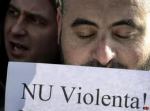What I really fear is time. That’s the devil: whipping us on when we’d rather loll, so the present sprints by, impossible to grasp, and all is suddenly past, a past that won’t hold still, that slides into these inauthentic tales.
Christian Marclay’s 24-hour video The Clock was acclaimed as one of the cultural highlights of 2010 when it was shown in London, so I was very excited when it came to New York.
In fact, I was so excited that I broke two of my rules – I woke up early at the weekend and I was prepared to queue. In fact, I waited for nearly three hours to get into the gallery on a February morning that was so cold that it started to snow. But I have to say The Clock was so fantastic that I would do it all over again.
Marclay has trawled through thousands of films and TV programmes to find scenes that reflect the passage of time and spliced them together so they unfold in real time over 24 hours – 1.15 in the afternoon in the video matched the actual time in New York.
It’s hard to explain the hypnotic effect of the video as you watch the time pieces on the screen. You are aware that something dramatic will happen on each hour, or half-an-hour, or quarter-of-an-hour, but at the same time, as in real life, you are aware that time is unstoppable and the bigger picture will continue to flow on regardless of the ripples created by these individual events.
The BBC News had a piece on the video which gives some idea of the experience. I only watched The Clock for a few hours one Saturday afternoon but would have loved to seen the whole 24 hours.
The New York Times had the same feeling:
Time is a kind of music, music is a kind of time, and Marclay — who’s worked with music for much of his career, as a turntablist, conceptual artist and filmmaker — seems to understand this implicitly. A 24-hour video composed of nothing but people all over the world, in many languages and from the beginning of moving images to now, tied to time, resenting it, making friends with it, sweating it or ignoring it or dying from it, becomes the mother of all jams.
The screen action in each viewing, for me, ran along the same rhythms: the clock’s rhythm and Marclay’s sequencing rhythm. And, in some sense, the heartbeat. It becomes a movie about mortality; it becomes a movie about staying alive.
The Economist met with Marclay towards the end of the two years it took him to edit his masterpiece – which puts my three-hour wait into perspective. Just as his video puts time, and life, into perspective.







